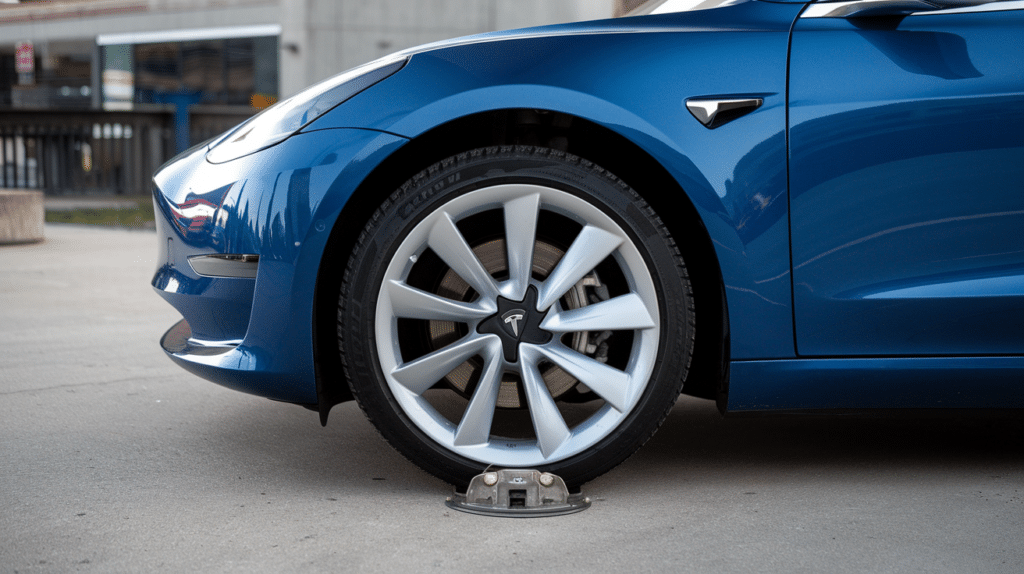As a Tesla Model 3 owner for the past three years, I’ve learned that understanding your car’s bolt pattern isn’t just about changing wheels – it’s about safety, performance, and making smart upgrades.
After helping countless other owners and making a few mistakes myself, I’ve put together this guide to share everything you need to know about Model 3 bolt patterns.
If you’re planning to upgrade those stock wheels or just want to be prepared for your first tire rotation, knowing these specs can save you time, money, and headaches. I’ve learnt some interesting quirks about the Model 3’s bolt pattern that most dealerships won’t tell you.
In this post, I’ll break down six essential things about Tesla Model 3 bolt specifications that I wish someone had told me when I first got my car.
What Is the Bolt Pattern for A Tesla Model 3?

The Tesla Model 3 uses a 5×114.3mm bolt pattern, which is a common configuration in modern vehicles. This means it has 5 lug nuts arranged in a circle, and the diameter of this circle (measured from the center of one lug to the center of the opposite lug) is 114.3 millimeters.
The center bore, which is the hole in the middle of the wheel that fits over the hub, is 64.1mm. This bolt pattern has remained consistent for all Model 3s from their introduction in 2017 through the present models.
This setup is shared with the Tesla Model Y, which makes wheel interchangeability possible between these two vehicles.
When looking for replacement or aftermarket wheels, it’s essential to match both the bolt pattern and center bore size exactly. This pattern is sometimes referred to as 5×4.5 inches in American measurements.
Understanding Tesla Model 3 Bolt Patterns and Their Compatibility
Basic Specifications
- 5×114.3mm bolt pattern – industry standard measurement
- 64.1mm center bore for precise fitment
- Common pattern shared with many modern vehicles
- Essential measurements for wheel compatibility
- Original equipment specifications from Tesla
Direct Compatibility
Direct fit with Tesla Model Y wheels. It matches most modern Honda vehicle patterns
It is compatible with recent Toyota models and fits many Hyundai and Kia vehicles
Perfect match for Lexus wheel swaps and it works with selected Mazda applications
Aftermarket Options
- Extensive selection from major wheel manufacturers
- Premium options from BBS, HRE, and Vossen
- Affordable alternatives from Enkei and Konig
- Many winter wheel packages available
Installation Requirements
Precise torque setting of 129 lb-ft. Use star pattern sequence for tightening.
Hub-centric rings often needed for aftermarket wheels, regular torque checks are recommended.
Professional installation advised for first-time wheel swaps
Safety Considerations
- Must meet Model 3’s specific load ratings
- Check torque after first 100 miles of driving
- Avoid using spacers or adapters
- Ensure proper hub-centric fitment
Common Upgrades
Popular to widen rear wheels for better traction. These are Compatible with staggered wheel setups
They work with larger brake calipers on performance models
Often upgraded for track day applications. Custom finish options are widely available
List of The Correct Bolt Patterns for Different Tesla Models
| Tesla Model 3 Variant | Year Range | Bolt Pattern | Center Bore | Lug Count | Factory Wheel Sizes | Torque Spec |
|---|---|---|---|---|---|---|
| Standard Range | 2017-2024 | 5×114.3mm | 64.1mm | 5 | 18″ or 19″ | 129 lb-ft |
| Long Range | 2017-2024 | 5×114.3mm | 64.1mm | 5 | 18″ or 19″ | 129 lb-ft |
| Performance | 2017-2024 | 5×114.3mm | 64.1mm | 5 | 20″ or 21″ | 129 lb-ft |
| RWD | 2021-2024 | 5×114.3mm | 64.1mm | 5 | 18″ or 19″ | 129 lb-ft |
| Dual Motor AWD | 2017-2024 | 5×114.3mm | 64.1mm | 5 | 18″ or 19″ | 129 lb-ft |
Additional Specifications:
- Thread size: M14 x 1.5
- Hub bore tolerance: +/- 0.1mm
- Maximum wheel load rating: 1,600 lbs per wheel
- Recommended wheel width range: 7.5″ to 9.5″
- Acceptable offset range: +35mm to +45mm
- Compatible with both hub-centric and lug-centric wheel designs
How to Identify the Correct Bolt Pattern for A Tesla Model 3
1. Check Your VIN Number
- Find your 17-character VIN on the driver’s side dashboard or in your Tesla app
- Enter it into Tesla’s official database to get exact specifications for your model year
- Call your local Tesla service center with your VIN for detailed wheel fitment information
- Use your VIN to verify bolt pattern compatibility when ordering aftermarket wheels
- Most reliable method for ensuring correct wheel specifications every time
2. Physical Measurement
- Measure between lug nut centers directly across from each other (should be 114.3mm)
- Get down to wheel level with a measuring tape and ensure measuring points are centered
- Double-check your measurements at multiple points around the wheel
- For accuracy, clean lug nut area before measuring to avoid debris interference
3. Visual Inspection
- Count the lug nuts – Model 3 has exactly 5 in a star pattern
- Check for even spacing between all lug nuts
- Look for any signs of previous wheel modifications or adapters
- Compare your wheel’s pattern to known 5×114.3mm wheels if possible
- Verify the center bore measurement of 64.1mm
- Document your findings with clear photos for reference
4. Digital Methods
- Download a reputable wheel fitment app to your smartphone
- Take clear, straight-on photos of your wheel for app analysis
- Use Tesla’s official configurator to verify original wheel specifications
- Cross-reference with Tesla forums and owner groups for confirmation
5. Professional Verification
- Visit a Tesla service center for official confirmation
- Consult with reputable wheel shops familiar with Tesla fitments
- Have a professional wheel specialist measure all dimensions
- Keep documentation of verified measurements for future reference
Comparisons Between Tesla Model 3’s and Other Brands’ Bolt Patterns with Prices
| Brand & Model | Bolt Pattern | Center Bore | OEM Wheel Price Range* | Compatible with Model 3? | Adapter Cost (if applicable) |
|---|---|---|---|---|---|
| Tesla Model 3 | 5×114.3mm | 64.1mm | $250-450/wheel | – | – |
| BMW i4 | 5x120mm | 72.6mm | $400-800/wheel | No | $80-150/set |
| Polestar 2 | 5x108mm | 63.4mm | $300-600/wheel | No | $90-160/set |
| Hyundai IONIQ 6 | 5×114.3mm | 67.1mm | $200-400/wheel | Yes (with hub rings) | $20-30/set (hub rings) |
| Mercedes EQE | 5x112mm | 66.6mm | $500-900/wheel | No | Not Recommended |
| Lexus IS EV | 5×114.3mm | 60.1mm | $350-650/wheel | Yes (with hub rings) | $25-35/set (hub rings) |
| Audi e-tron GT | 5x112mm | 66.5mm | $600-1,100/wheel | No | Not Recommended |
| Kia EV6 | 5×114.3mm | 67.1mm | $200-450/wheel | Yes (with hub rings) | $20-30/set (hub rings) |
Key Takeaway:
- Price ranges are approximate for original equipment (OEM) wheels as of 2024
- Aftermarket wheels typically cost 20-40% less than OEM options
- Using adapters for incompatible patterns isn’t recommended for safety reasons
- Hub rings are a safe solution when only the center bore differs
- Prices vary based on: Wheel size (18″ to 21″), material (cast, flow-formed, or forged), design complexity, surface finish, brand premium
How to Maintain Bolt Patterns on Your Tesla Model 3

- Keep your Model 3’s lug nuts at exactly 129 lb-ft using a quality digital torque wrench.
- Check them monthly to maintain optimal wheel security and prevent loosening.
- Clean your wheel hubs and lug holes thoroughly every 6 months with brake cleaner and a wire brush.
- Apply a thin layer of anti-seize compound only on the hub center, never on lug threads.
- Get professional wheel alignment at a Tesla service center every 12,000-15,000 miles and track tire wear patterns between visits.
- For seasonal wheel changes, always mark wheel positions before removal.
- Use Tesla-specific jack pads at the correct lifting points.
- Invest in essential tools: a digital torque wrench, proper socket set, Tesla jack pads and wheel chocks for safe maintenance work.
- Build an emergency kit with a compact torque wrench, correct socket size, spare lug nuts, and Tesla roadside assistance contact info
- Monitor your tire pressure regularly through the Tesla app and keep a portable TPMS tool handy for accurate pressure checks
Remember: As a fellow Model 3 owner, I’ve found that spending a bit more on quality tools upfront has saved me money in the long run. These maintenance routines have kept my Model 3’s wheels in perfect condition for over 40,000 miles!
Conclusion
After digging deep into the Model 3’s bolt patterns, I hope you’re feeling more confident about handling your Tesla’s wheel-related needs. Remember, that 5×114.3mm pattern isn’t just a random number – it’s your key to safe and proper wheel fitment.
If you found this guide helpful, you might want to check out my previous blog on Mini Cooper bolt patterns for an interesting comparison between Classic British engineering and modern EV design.
The world of Tesla modifications is constantly evolving, and I’ll keep updating this guide as new wheel options hit the market.
For now, focus on maintaining that crucial 129 lb-ft torque spec and never compromise on hub-centric fitment.
If you’re sticking with stock wheels or planning an upgrade, your Model 3’s bolt pattern is literally what keeps your EV dreams rolling smoothly.
Got questions? Drop them in the comments below!


